
Investigating Lyme disease in the Scottish Western Isles
Lyme disease, or Lyme borreliosis, is a potentially serious zoonotic disease that appears to be on the rise in the UK, Europe and North America. One hotspot that has emerged in recent years are the Outer Hebridean islands of Uist, where the incidence of Lyme disease is twenty times higher than the Scottish national average. Our researchers are working on a multi-year project to understand more about Lyme disease on these islands which will in turn provide wider insights into the disease in the UK and Europe.
Lyme disease is the most common vector-borne disease in the northern hemisphere. It is a bacterial infection caused by the spirochete bacterium Borrelia burgdorferi, which is transmitted to animals and humans through the bites of infected blood-sucking ticks. Ticks become infected when they feed on infected hosts, such as small mammals or birds, which are reservoirs for the bacteria. The percentage of ticks infected varies between locations but in the UK rarely exceeds five to ten per cent. After hatching from an egg, ticks must have a blood meal at every stage of their life cycle - larva, nymph and adult - in order to survive. Most infections in humans are caused by bites from ticks in the nymphal stage.
In humans, early symptoms of Lyme disease can include a rash and flu-like symptoms. If left untreated, more severe and long-lasting symptoms can develop months to years later. These include neurological disease, heart disease, arthritis and chronic skin lesions.
Though surveillance of Lyme disease varies between countries, there is generally a perception that it is a growing problem. In the UK, it is increasingly recognised as a public health issue. The islands of North Uist, South Uist and Benbecula in the Scottish Outer Hebrides particularly stand out, as the incidence of Lyme disease there is far greater than on neighbouring islands or the mainland.
Dr Caroline Millins and Dr Roman Biek from the Institute of Biodiversity, Animal Health & Comparative Medicine are seeking to understand why this is the case in order to help the Uist community manage ticks and the Lyme disease risk more effectively.
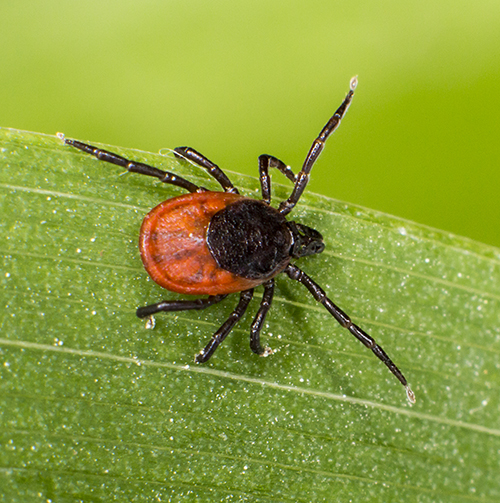
Ticks transmit Lyme disease
Research
The researchers were first alerted to the problem on Uist by Isabell MacInnes, a public health nurse at a national Lyme disease meeting in 2017 and have since been undertaking research to understand more about the ecology of Lyme disease on the islands as well as who is most at risk.
Together with local public health, environmental, veterinary and community stakeholders, Dr Millins and Dr Biek developed three key research questions.
The first two questions examined the ecology of the disease on Uist: what is the prevalence of B. burgdorferi in ticks and which strains are present in the Uists? And what are the environmental factors, including wildlife species, associated with infection risk?
To answer these questions, the researchers carried out systematic sampling of over 5000 ticks across the Uists and neighbouring islands of Barra and Harris. The field work comprised quantifying tick numbers by dragging a one metre square blanket over the ground vegetation to collect any questing ticks. This was done in measured 10 metre transects. Dr Millins explains: “Ticks are ambush predators so they grab on to the blanket as if it is a host passing by.” The ticks were counted and then taken back to the lab to test for B. burgdorferi.
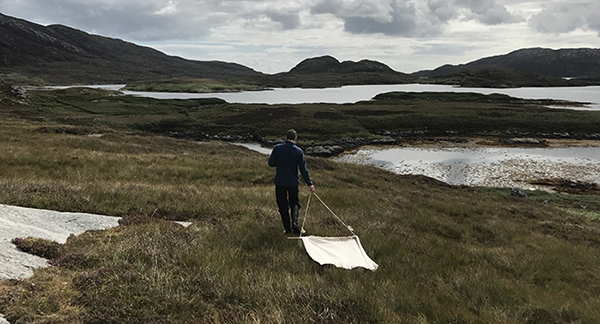
Other environmental data was also collected including habitat type and temperature, humidity and evidence of reservoir hosts, such as tunnels, indicating the presence of rats and other small mammals. Deer and sheep abundance were also noted as this can affect the numbers of ticks.
A third research question investigated in which areas of the islands people are more likely to be exposed to infected ticks, and who is at greatest risk.
To answer this, the researchers undertook a public consultation with the local community using a questionnaire survey which had been developed with community stakeholders. This gathered information on where people lived, their occupation, their outdoor activities, whether they had pets and if, when and where they’d been bitten by a tick.
“We wanted to create a map of tick bite locations and compare that to the information that we were getting on the ecological risk in different habitats and on different islands” explains Dr Millins, “we also wanted to assess demographic, social and occupational factors which were associated with tick bites.”
The survey garnered an excellent response rate; around two per cent of the population of the Outer Hebrides.
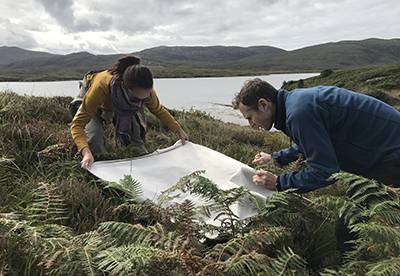
Counting ticks
Findings
Though the research is still ongoing, Dr Biek and Dr Millins have already made some significant findings.
Their analysis of the tick samples collected revealed that approximately 7 per cent of ticks on Uist were infected, which is a somewhat higher proportion of ticks compared to the average across Scotland. This confirms that the presence of B. burgdorferi on the Uists is higher, though not enough to solely explain the twenty-fold increase in Lyme disease cases, exposing that there must be other factors at work.
The tick sample analysis also revealed that the genospecies of B. burgdorferi that is present in the majority of ticks on Uist is one that is exclusively associated with small mammals but not birds: “We were somewhat surprised that the circulation of the pathogen appears to be so strongly driven by small mammals” states Dr Biek, “however, this makes it easier to study as it narrows it down to just a few potential host species.”
Another key discovery that emerged from the public consultation was the common peri-domestic exposure of people to ticks. The survey results revealed that around a quarter of the people who recalled the site of their last tick bite, had been bitten in their garden, and over 70 per cent of people had been bitten within a kilometre of their home. As a result of this information, the researchers subsequently adapted their field sampling to include gardens with the assistance of stakeholders on the Uists and found that the abundance and infection with B. burgdorferi of ticks in gardens was as high as in other habitats where ticks are commonly encountered.
This was unexpected and one of the first reports highlighting the risk of peri-domestic exposure to ticks in the UK. This type of exposure has previously been more associated with Lyme disease in North America, where people’s homes and gardens often border natural woodlands, allowing deer, and the ticks they carry, to enter gardens frequently.
“Typically, in the UK and Europe, human exposure to ticks is considered to be from recreational activities such as hiking, or related to occupations such as forestry. Tick exposure in gardens as is commonly reported in the Outer Hebrides isn’t so well recognised in Europe, but may be under-reported” says Dr Millins.
The reasons for this are not yet known, but houses and gardens in the Hebrides are often surrounded by crofts, which the researchers found to be suitable tick habitat. There are several host species on croft grasslands, including sheep and deer, which carry ticks and through moving around could be aiding their spread into gardens.
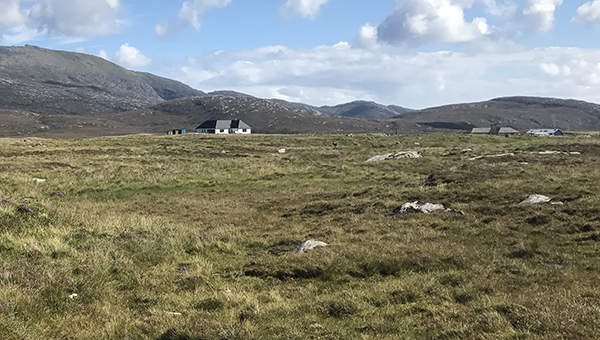
The researchers' findings on the risk of peri-domestic Lyme disease in the Hebrides will contribute to updated public health messaging and educational initiatives for the islands, as Dr Biek explains:
“We’re aiming to tell people what kind of activities might put them more at risk, or what they could change about their gardens. For example, whether deer fencing is justified, or whether there are other things they could do to reduce the risk of encountering an infected tick.”
Maps of tick exposure will be also be produced from the results of their questionnaire and integrated with NHS Western Isles public health initiatives.
For the work currently ongoing, the research team also includes Dr Lucy Gilbert, a specialist in tick ecology, who recently joined the University of Glasgow.
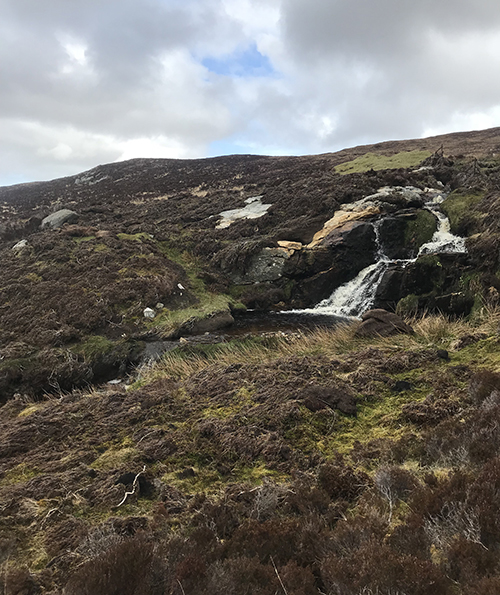
Moorland on Uist
The role of deer
The role of deer in the spread of Lyme disease is a contested issue. There is a widespread misconception that deer infect ticks with the bacterium however deer are not reservoir hosts and so do not transmit B. burgdorferi to ticks. They are, however, a reproduction host for the tick by providing a blood meal to adult female ticks, enabling production of eggs which hatch to larvae. Moreover, significantly, as deer move around with ticks attached to them, they can be responsible for distributing ticks across large areas.
On Uist, as a result of the public consultation, the role of red deer have now become a major focus for Dr Millins’ and Dr Biek’s research plans. The survey revealed that the community had widespread concerns about ticks now being present in parts of the islands where they used to be absent.
“It is commonly reported by the community in consultations that the tick distribution on the Uists has changed,” says Dr Millins. “Ticks used to be more of a problem on the east side of South Uist but now they’re being found increasingly on the west side of the island where the majority of the population lives.”
This changing tick distribution coincides with an increase in deer populations alongside anecdotal evidence that deer are commonly moving from the moorland on the east side of the island to the croft land on the west side to forage on the resources there.
The community and various other stakeholders are therefore keen to manage the deer issue. Consequently, one of the key outputs of Dr Millins’s and Dr Biek’s research will be recommendations about deer management on the island.
“Marauding deer on the west side of the islands close to crofts and people’s homes are a concern for the community and the deer management group, both for causing damage to crops and also as a risk of introducing ticks to areas where livestock are kept and people spend most of their time” explains Dr Millins. “The community are keen to know what the effects of deer management, either by reducing the deer numbers or fencing would be on tick numbers and Lyme disease risk. But there are differences in opinions as to the role of deer in supporting tick populations and it’s a sensitive issue. So we’re working with all of the stakeholders; the deer estates, the community, the deer management group and crofters, to provide the information the community needs to base management decisions on.”
Livestock pathogens
Through regular discussions with the community, the researchers also became aware that, in addition to Lyme disease, tick-borne pathogens in livestock, such as louping ill virus and Anaplasma phagocytophilum, were an increasing concern for the Uist community. These pathogens are spread by the same ticks that carry Lyme disease.
To investigate this, a parallel survey was designed and distributed to local crofters. This also received a good response and revealed reports of significant livestock morbidity and mortality due to tick-borne pathogens over the same time period that Lyme disease has been on the increase.
“This is a big problem for the community as a large proportion of the population on these islands have livestock and crofting is a way of life for them.” states Dr Biek, "so people feel that these diseases could really threaten that.”
As a result of this crofter consultation, the researchers are aiming to obtain funding to further assess the risk of tick-borne pathogens in livestock and potential interventions.
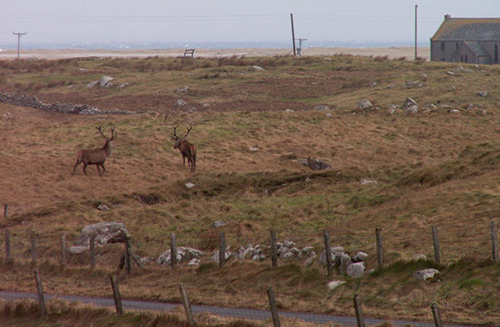
Red deer on Uist
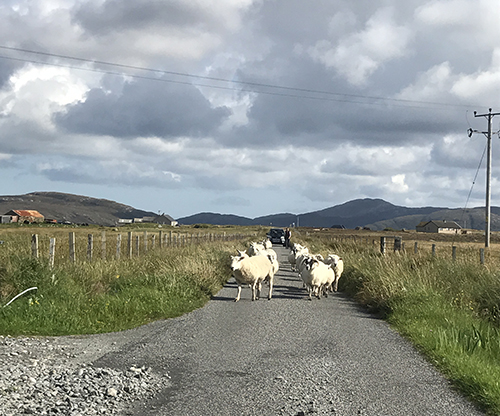
Livestock on Uist
Wider impact
As well as their research being used to help the residents of Uist, the researchers hope that their findings will translate into a better understanding of the ecological drivers of Lyme disease more generally:
“The island system in the Hebrides provides a ‘natural laboratory’ with varying host communities which we can use to test hypotheses of reservoir host importance," says Dr Millins. "The islands also lend themselves well to connecting between stakeholders which has really accelerated our research by being able to relate the ecological findings to tick exposure in the community and clinical disease in people. We aim to extrapolate the lessons and approaches that we’re learning on Uist to work on mainland Scotland and elsewhere in Europe.”
The peri-domestic risk in particular could apply to other areas of the UK and Europe, and education initiatives could be updated to reflect this, as Dr Biek states: “I think one of the wider impacts might be that there needs to be more of an awareness that there are multiple ways in which you can encounter a tick, and just recommending to search yourself after you’ve been hillwalking may not be enough. We have to think about other places where people put themselves at risk”.
Moreover, deer management is now one of the biggest environmental issues for the Scottish government and there is a growing awareness about their role in tick-borne diseases so any deer management recommendations on Uist could help to inform government policy on deer.
Their work on Uist has also potentially exposed fundamental questions about the kind of habitats the pathogen can thrive in, as Dr Biek explains:
“Lyme disease is traditionally associated with forests and woodlands, but on Uist the landscape is predominantly grass – and moorland with few trees. We’ve always been puzzled by this, but it might give us some insight into why the Scottish highlands are considered a high risk area for Lyme disease. Yes, you could say it’s because there’s more recreational activity in the highlands, but what if it’s also something else? Maybe there are habitats that pose a higher risk than we had appreciated before. If you can have full transmission cycles in non-forested areas like Uist, then why not also in parts of the highlands that are environmentally similar. So this is a research area that we will be pursuing.”
Funding
For their research on Uist, Dr Biek and Dr Millins have received funding from the University of Glasgow’s Knowledge Exchange Fund, The Wellcome Trust and The Natural Environment Research Council.
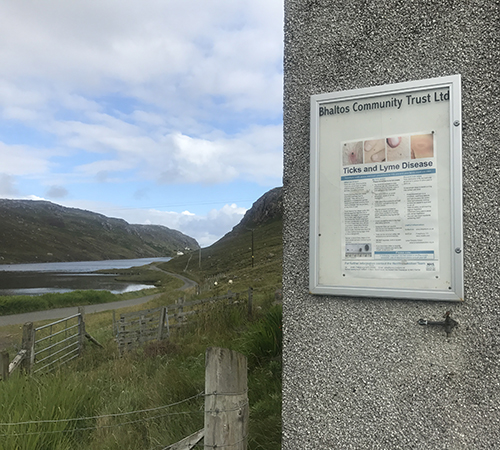
Lyme disease public health messaging on Uist

